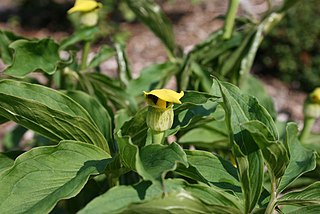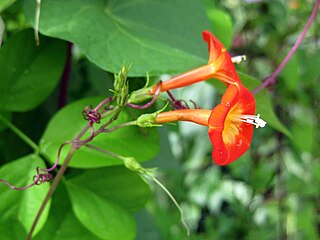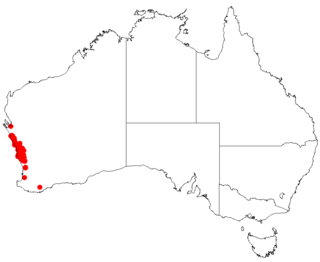
Sesuvium portulacastrum is a sprawling perennial herb that grows in coastal areas throughout much of the world. It is commonly known as shoreline purslane or (ambiguously) "sea purslane," in English, and dampalit in Tagalog.

Forsskaolea tenacissima is a member of the non-stinging nettles genus Forsskaolea and is in the same family as the stinging kind, Urticaceae. Described as "looking like a tough character that does not want or need a caress", F. tenacissima makes its home where not many plant species survive, in stony soils, road edges, in the gravel wadi and "in the rock crevices and water-receiving depressions" above the stone pavements of the Hamadas.

Arisaema flavum is a species of flowering plant widespread across north-eastern Africa and southern Asia. It is native to Ethiopia, Somalia, the Arabian Peninsula, Pakistan, Afghanistan, Nepal, Assam, Himalayas, Tibet, Yunnan, and Sichuan. The species epithet flavum is Latin for yellow and indicates its flower colour.

Ipomoea coccinea is a flowering plant in the family Convolvulaceae known by several common names including red morning glory, redstar and (ambiguously) Mexican morning glory.
Luzula nivalis, commonly known as arctic wood-rush or less commonly as snowy wood-rush, is a species of perennial rush native to the North American Arctic and Northern Europe. It was described by Polunin (1940) as one of the most abundant, ubiquitous, and ecologically important of all arctic plants.

Stipa pulcherrima, golden feather grass is a bisexual flowering plant in the family Poaceae.
Melica arzivencoi is a grass species in the family Poaceae that is endemic to Brazil where it can be found in Rio Grande do Sul. It was described by Valls and Barcellos in 1973.
Melica rigida is a species of grass found in Argentina, Brazil, and Uruguay.
Pentaphylax euryoides is a species of flowering plant in the Pentaphylacaceae family that can in be found on Sumatra and in such countries as Malaysia, Vietnam and China. In China, it is found in such provinces as Guangdong, Guangxi, Guizhou, Hainan, Yunnan, and in southern parts of Fujian, Hunan, and Jiangxi.
Betula austrosinensis is a species of birch that is endemic to China where it is found on elevation of 700–1,900 metres (2,300–6,200 ft).

Festuca dolichophylla is a species of grass which is endemic to western South America with an occurrence in Costa Rica.
Aspidistra campanulata is a species of flowering plant. A. campanulata grows in evergreen forests on very steep slopes of eroded limestone mountains in Vietnam. Its name is due to the bell shape of its perigone.
Aspidistra recondita is a species of flowering plant. A. recondita takes its name from the Latin reconditus, meaning "hidden", referring to its sexual organs being completely hidden inside its ovoid perigone, with a small opening. Given it was described from an A. lurida specimen, neither its distribution nor habitat are known.
Aspidistra umbrosa is a species of flowering plant. Given it was described from an unclassified Aspidistra specimen from another study, neither its distribution nor habitat are known.

Ipomoea oenotherae is a species of plant of the morning glory genus, Ipomoea, in the family Convolvulaceae. It derives its name from the resemblance it bears to plants in the genus Oenothera. Ipomoea oenotherae is a succulent and a cryptophyte.

Persoonia terminalis, also known as the Torrington geebung, is a rare shrub belonging to the family Proteaceae, and native to northern New South Wales and southern Queensland in eastern Australia. Reported as a subspecies of Persoonia nutans in 1981, it was described as a species by Lawrie Johnson and his colleague Peter Weston in 1991.

Hakea auriculata is a reasonably common shrub in the family Proteaceae endemic to Western Australia. A very showy species in full bloom with creamy white, yellow, dark red or reddish purple fragrant flowers.

Hakea kippistiana is a shrub in the family Proteacea and endemic to Western Australia. It is a dense prickly shrub with sharp needle-shaped leaves with fragrant white, cream or pink flowers from November to February.
Hakea tuberculata is a shrub in the family Proteaceae, endemic to several isolated areas along the coast in the Peel, South West, Great Southern and Goldfields-Esperance regions of Western Australia.

Felicia fruticosa is a strongly branching shrub of up to 1.3 metres high that is assigned to the daisy family with flower heads consisting of about twenty purple to white ray florets encircling many yellow disc florets, and small flat, entire and hairless leathery leaves. Two subspecies are recognized. Felicia fruticosa subsp. brevipedunculata, from the Limpopo Province of South Africa is up to 1.3 metres tall and has longer leaves of 2.5 centimetres (0.98 in) long and 2 millimetres (0.079 in) wide and nearly seated pale violet to white flower heads. Felicia fruticosa subsp. fruticosa, from the Western Cape province of South Africa, is no more than 1 m and has shorter leaves of 1.25 centimetres (0.49 in) long and 2.5 millimetres (0.098 in) wide with flower heads on largely leafless, about 2.5 centimetres (0.98 in) long stems. It is sometimes called bosastertjie in Afrikaans. In the wild, flower occurs from August till October.











